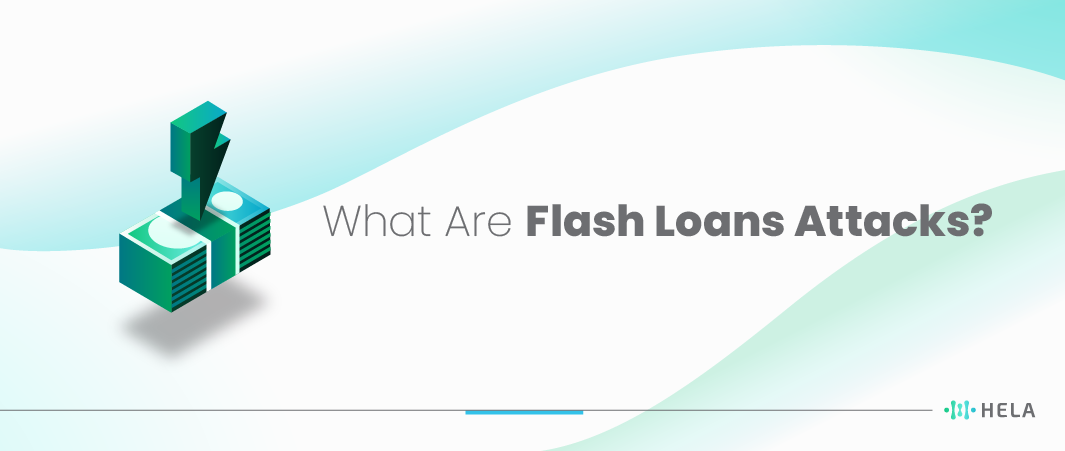In the fast-paced world of decentralized finance (DeFi), one buzzworthy term that’s been creating quite a stir is the “flash loan attack.” This intriguing yet concerning concept has been turning heads in the DeFi community due to its potential to shake up the ecosystem. In this article, we’ll dive into what these flash loan attacks are, how they play out, and the implications they carry for both DeFi enthusiasts and the platforms they rely on.
So, what exactly is a flash loan attack? It’s a cunning move in which a user borrows a sizeable amount of bitcoin without any form of security in order to return it in the same transaction. This might seem harmless, but in the wrong hands, it could cause a lot of damage. These attacks can exploit vulnerabilities in DeFi protocols, causing significant financial losses. The consequences ripple through the community, with users and platforms left grappling with the aftermath.
For DeFi users and platforms, the rise of flash loan attacks is akin to a double-edged sword. On one hand, they can harness these flash loans for legitimate financial opportunities and arbitrage. However, there’s also the looming risk of malicious actors taking advantage of these same mechanisms to drain liquidity from a DeFi platform, leading to substantial financial losses. As the DeFi landscape continues to evolve, understanding these attacks and fortifying against them becomes essential for both the curious DeFi explorer and the platform developer alike.
The Basics of Flash Loans

Flash loans represent a unique and innovative concept within the world of decentralized finance (DeFi). They allow users to borrow assets without having to provide any security, but there is one important requirement: the borrowed amount must be repaid inside the same transaction block. This basically means that everything happens in a handful of seconds. These flash loans have unlocked various opportunities, including arbitrage, collateral swaps, and refinancing, among other practical applications.
However, it’s essential to be aware that while flash loans can be beneficial, there is a flip side to this coin – the possibility of a flash loan attack. These attacks occur when malicious actors exploit vulnerabilities in smart contracts and use flash loans to manipulate markets or steal funds. Nevertheless, for those using flash loans legitimately, the risk for lenders is theoretically minimal, as long as the borrowed amount is repaid promptly.
In the broader DeFi landscape, flash loans have empowered users by eliminating the need for traditional collateral, enabling quick and efficient financial operations. Their ability to be executed within a single transaction block has introduced a new level of flexibility and efficiency, making them a valuable tool for those who understand their potential and the associated risks.
Also Read: Crypto Market Sentiment: Impact on Cryptocurrency Valuations
What are Flash Loan Attacks?
A flash loan attack is a clever, yet concerning maneuver in the world of decentralized finance (DeFi). Picture this: someone can borrow a significant amount of cryptocurrency through a flash loan, and in one swift transaction, they exploit vulnerabilities in DeFi protocols, messing with the market or the protocol’s workings. Once they’ve made their moves and secured some profit, they return the loan. These attacks have gained notoriety because of their lightning speed and the potential for big wins or losses, depending on which side you’re on.
These flash loan attacks have raised eyebrows due to their rapid execution. In a single transaction, an attacker can execute a sequence of borrow, manipulate, and repay actions. The aftermath of such an attack can leave DeFi protocols and their users in a state of disarray, trying to pick up the pieces. So, it’s a bit like a financial magic trick, but one that can have significant consequences for the DeFi ecosystem and its participants.
Real-world Implications of Flash Loan Attacks
DeFi (Decentralized Finance) exploits, such as flash loan assaults, have important real-world repercussions for the cryptocurrency and blockchain industries as well as the larger financial ecosystem. Due to their high-profile nature and the potential for significant financial rewards for the assailants, these attacks have drawn attention. Here, we’ll examine the bigger picture and how flash loan attacks affect everyday life.
Destabilizing Effect on DeFi Protocols
Flash loan attacks can exploit vulnerabilities in smart contracts within DeFi platforms. When a successful attack occurs, it can lead to significant losses for these platforms, eroding user trust, and potentially destabilizing the DeFi ecosystem.
Erosion of Trust
The cryptocurrency and DeFi spaces rely heavily on trust and community confidence. When high-profile flash loan attacks occur, it can undermine that trust, discouraging both retail and institutional investors from participating in these financial systems.
Regulatory Scrutiny
Regulatory bodies around the world are closely monitoring the cryptocurrency and DeFi sectors. Flash loan assaults, which can be used to facilitate tax evasion, money laundering, and other illegal actions, might draw increased regulatory scrutiny and result in future rules that are more onerous.
Risk for Decentralized Exchanges (DEXs)
Many flash loan attacks target decentralized exchanges. As these exchanges gain more prominence in the crypto space, such attacks could deter users from using DEXs and push them back toward centralized exchanges.
Increased Security Measures
Flash loan attacks highlight the need for enhanced security measures within DeFi platforms and blockchain projects. Developers and security experts must continuously work to identify vulnerabilities and improve smart contract security.
Insurance and Risk Management
The rise of flash loan attacks has led to a growing market for decentralized insurance and risk management solutions within the DeFi ecosystem. This can help mitigate losses and provide a safety net for users.
Educational Initiatives
Flash loan attacks underscore the importance of educating users about the risks associated with DeFi and cryptocurrency investments. Both investors and developers must be aware of potential threats and best practices to mitigate risks.
Evolving Attack Vectors
As the cryptocurrency space evolves, so do the attack vectors. Flash loan attacks serve as a reminder that malicious actors are becoming increasingly sophisticated and innovative in their methods, necessitating continuous vigilance from the crypto community.
Collaboration and Transparency
The community’s response to flash loan attacks emphasizes the importance of collaboration and transparency. Developers, security researchers, and exchanges frequently collaborate to find vulnerabilities, fix them, and communicate details on attacks and potential threats..
Beyond the strikes’ immediate financial effects, flash loan attacks have significant real-world ramifications. They affect trust, regulatory scrutiny, and the development of DeFi and blockchain technology. As the industry matures, addressing these issues and mitigating risks will be essential for its long-term sustainability and growth.
How Protocols are Safeguarding Against These Attacks

Flash loans are a type of attack in the decentralized finance (DeFi) space where malicious actors borrow a significant amount of cryptocurrency in a single transaction with no collateral, manipulate the market, and repay the borrowed amount within the same transaction. These attacks can cause significant disruptions to DeFi platforms, leading to substantial financial losses for users. To safeguard against flash loan attacks, various protocols and DeFi projects have implemented several strategies and security measures. Here’s an overview of how these safeguards work:
Liquidity Thresholds
Many DeFi protocols have implemented liquidity thresholds. These thresholds ensure that a certain minimum amount of liquidity must be available in a pool before a flash loan can be executed. If the threshold isn’t met, the loan won’t go through, reducing the risk of flash loan attacks.
Timelocks
Timelocks are delay mechanisms that require a protocol to wait for a specified period before implementing changes or executing transactions. They prevent flash loans from manipulating a protocol within a single block and give the community and developers time to react and prevent malicious activities.
Price Oracles and Manipulation Checks
To prevent flash loan attacks from manipulating the price of assets, DeFi protocols use decentralized price oracles and perform checks to ensure that the price of assets remains within a reasonable range during transactions. If a significant price deviation is detected, the transaction may be canceled.
Staged Transactions
Protocols may require flash loans to be divided into multiple stages, where each stage must be executed in a separate transaction. This can make it more difficult for attackers to manipulate prices or carry out other malicious activities within a single transaction.
White-Listing
Some DeFi protocols maintain a list of trusted addresses that are allowed to interact with the protocol. Flash loan contracts may not be on this list, preventing them from accessing the protocol.
Governance and Community Involvement
Many DeFi platforms have strong governance systems where changes to the protocol require a community vote. This allows the community to quickly respond to any potential attacks or vulnerabilities by voting to halt the protocol or make necessary adjustments.
Insurance and Compensation Funds
Some DeFi projects have set up insurance or compensation funds to reimburse users in the event of a flash loan attack. This provides an additional layer of protection to users who may suffer losses.
Third-Party Audits
To identify vulnerabilities and ensure the security of their smart contracts, many DeFi projects undergo regular audits by reputable third-party security firms. These audits help in discovering and mitigating potential attack vectors.
Advanced Risk Management Strategies
DeFi protocols are increasingly implementing advanced risk management strategies, including circuit breakers, which can halt trading in the event of extreme market volatility or suspicious activities.
Continuous Monitoring and Research
DeFi projects continuously monitor their platforms for unusual activities and conduct research to stay ahead of emerging attack methods. This proactive approach helps in the early detection and mitigation of threats.
While these safeguards have significantly improved the security of DeFi protocols against flash loan attacks, it’s important to note that the DeFi space is still evolving, and new attack vectors may emerge. As such, it’s crucial for DeFi projects to remain vigilant, adapt to changing threats, and continue developing innovative security measures to protect their users.
Also Read: What Is Asset Tokenization? Converting Real Assets into Digital Assets for Beginners
What Users Can Do to Protect Themselves

Flash loans enable individuals to borrow large sums of cryptocurrency without collateral, execute transactions within a single block, and return the borrowed funds in the same transaction. These attacks are primarily carried out on platforms like Ethereum, Binance Smart Chain, and other blockchain networks. Here’s how users can protect themselves from flash loan attacks:
Understand Flash Loans
Before participating in any DeFi platform, it’s crucial to understand how flash loans work. Knowing the mechanics behind these loans will help you recognize potential vulnerabilities and make informed decisions.
Use Reputable Platforms
Stick to well-established DeFi platforms that have a track record of security and transparency. Check for audits, community reviews, and the reputation of the platform and the developers.
Diversify Investments
Don’t put all your funds into a single DeFi protocol. Diversifying your investments across multiple platforms can mitigate the risk of losing all your assets in a flash loan attack.
Stay Informed
Keep up with the latest news and developments in the DeFi space. Follow official social media channels, forums, and communities to stay informed about potential risks and vulnerabilities.
Check for Audits
Many DeFi projects undergo security audits by third-party firms. Look for projects that have been audited and review the audit reports to understand any potential risks.
Use Limit Orders
When making transactions on decentralized exchanges (DEXs), consider using limit orders instead of market orders. This can prevent unexpected price fluctuations that could be exploited by attackers.
Implement Multi-Signature Wallets
Consider using multi-signature wallets that require multiple approvals for transactions. This can add an extra layer of security to your assets.
Set Transaction Limits
Some DeFi platforms allow you to set transaction limits or whitelist specific addresses. Use these features to control the movement of your funds and prevent unauthorized withdrawals.
Avoid Unaudited or New Projects
Be cautious about investing in unaudited or newly launched DeFi projects. Wait for projects to prove their security and reliability over time before getting involved.
Use Strong Passwords and Hardware Wallets
Protect your wallet with strong, unique passwords, and consider using hardware wallets for added security. Hardware wallets are less susceptible to hacks compared to software wallets.
Beware of Phishing
Always double-check the website’s URL before entering sensitive information or making transactions. Be cautious of phishing attempts, as attackers may impersonate legitimate websites.
Monitor Your Accounts
Regularly check your wallet balances and transaction history. Detecting suspicious activity early can help prevent significant losses.
Use Security Tools
Explore security tools such as blockchain explorers and DeFi-specific monitoring platforms that can help you keep an eye on your assets and transactions.
Consider Insurance
Some DeFi projects offer insurance coverage against potential losses due to smart contract vulnerabilities or hacks. Explore these options to protect your investments.
Remember that while these measures can reduce the risk of flash loan attacks and other DeFi-related vulnerabilities, there is always some level of risk involved in the cryptocurrency space. Therefore, exercise caution and conduct thorough research before participating in any DeFi project.
Conclusion
Flash loan attacks, while alarming, are an integral part of the evolutionary process of any emerging technology. They highlight vulnerabilities, pushing the DeFi community to innovate, adapt, and implement more robust security measures. The dynamism of this space, coupled with its promise of democratizing finance, ensures that it will continue to attract both enthusiasts and skeptics.
Individuals and protocols alike must tread cautiously, embracing the opportunities DeFi presents while being acutely aware of its pitfalls. As the adage goes, with great power comes great responsibility. In the world of DeFi, where the power to revolutionize finance is immense, the responsibility to ensure its safe and sustainable growth is equally significant.
Disclaimer: The information provided by HeLa Labs in this article is intended for general informational purposes and does not reflect the company’s opinion. It is not intended as investment advice or recommendations. Readers are strongly advised to conduct their own thorough research and consult with a qualified financial advisor before making any financial decisions.

Joshua Soriano
I am a writer specializing in decentralized systems, digital assets, and Web3 innovation. I develop research-driven explainers, case studies, and thought leadership that connect blockchain infrastructure, smart contract design, and tokenization models to real-world outcomes.
My work focuses on translating complex technical concepts into clear, actionable narratives for builders, businesses, and investors, highlighting transparency, security, and operational efficiency. Each piece blends primary-source research, protocol documentation, and practitioner insights to surface what matters for adoption and risk reduction, helping teams make informed decisions with precise, accessible content.
- Joshua Soriano#molongui-disabled-link
- Joshua Soriano#molongui-disabled-link
- Joshua Soriano#molongui-disabled-link
- Joshua Soriano#molongui-disabled-link

